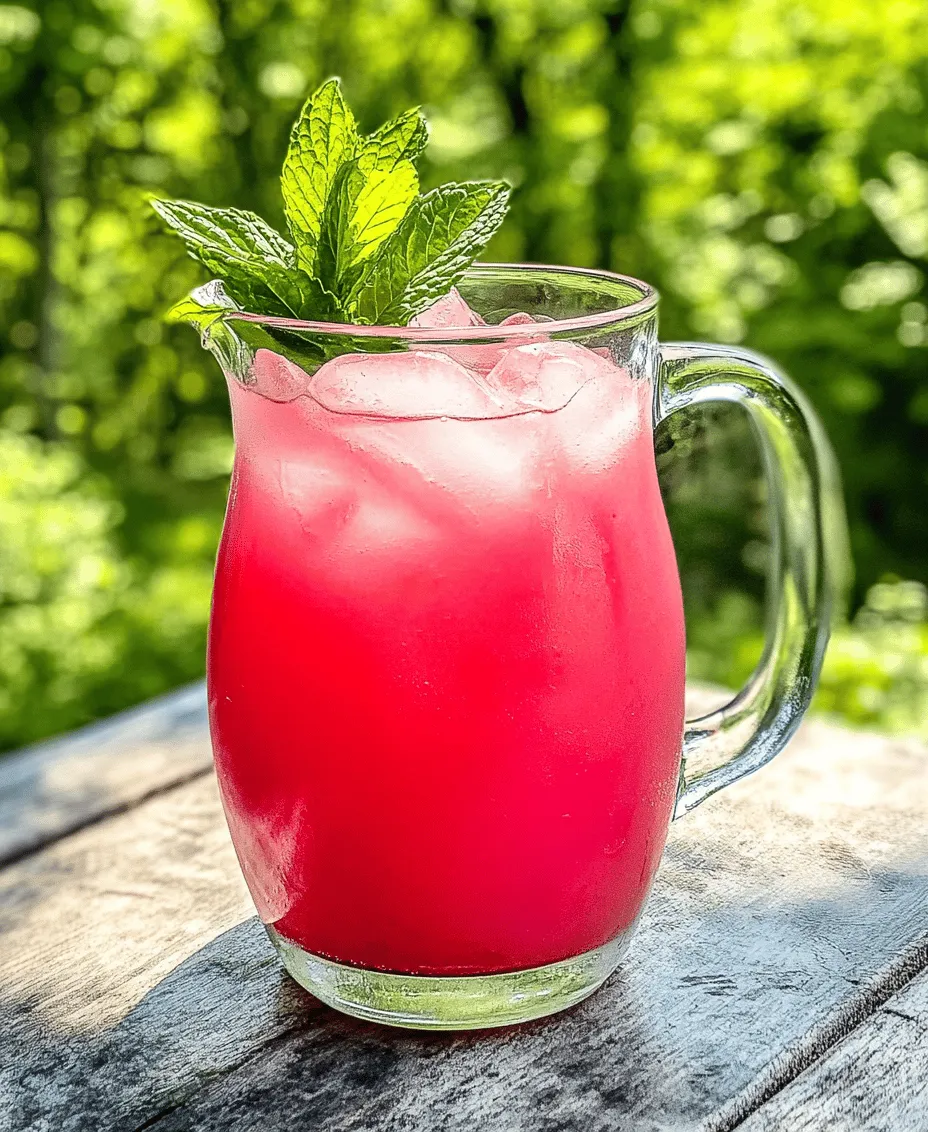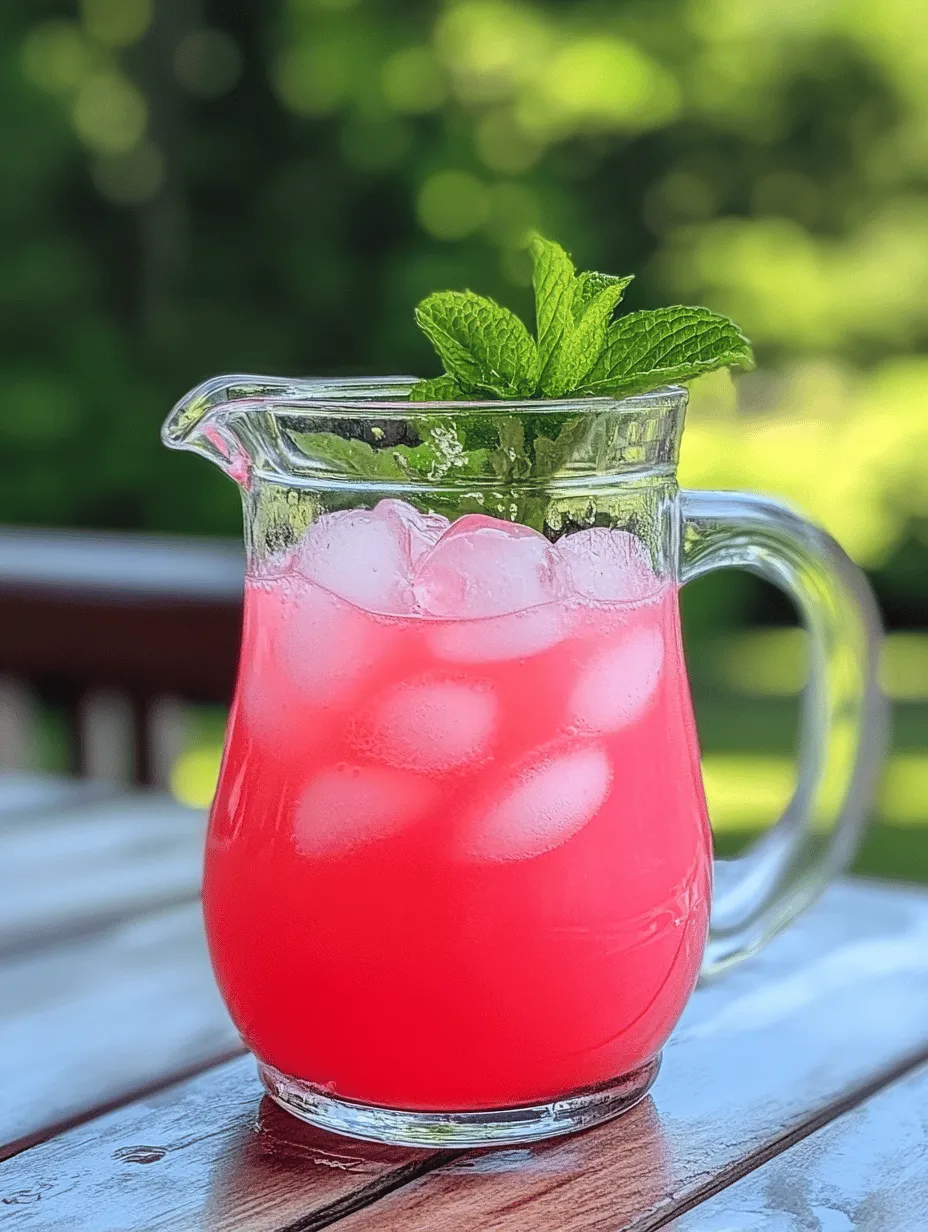Introduction
As the sun blazes overhead and temperatures rise, nothing quenches thirst quite like a glass of lemonade. This timeless summer beverage, revered for its refreshing qualities, finds its way into backyard barbecues, picnics, and lazy afternoons spent lounging by the pool. While traditional lemonade has its charm, a delightful twist on this favorite drink is taking summer refreshment to new heights: watermelon lemonade. This vibrant concoction combines the classic tartness of lemons with the sweet juiciness of ripe watermelon, resulting in a drink that not only tantalizes the taste buds but also provides a cooling reprieve from the heat.
Watermelon lemonade is more than just a pretty drink; it’s a celebration of summer’s bounty, encapsulating the essence of the season in every sip. Watermelon, with its refreshing taste and hydrating properties, pairs beautifully with zesty lemon, creating a beverage that is both delicious and nutritious. Beyond its delightful flavor, this drink offers an array of health benefits, making it a perfect choice for those looking to enjoy a guilt-free indulgence during the warm months.
In this article, we will delve into the preparation of refreshing watermelon lemonade, exploring its ingredients and guiding you through the steps to create this summer sensation. Whether you’re throwing a garden party or simply looking to cool down after a hot day, this drink is sure to impress.
Understanding the Ingredients
Fresh Watermelon
At the heart of watermelon lemonade is, of course, the star ingredient: fresh watermelon. This juicy fruit is not only a delightful treat but also a nutritional powerhouse. Watermelon is composed of about 92% water, making it an excellent choice for hydration during hot weather. It is low in calories and packed with vitamins A and C, both of which support skin health and boost the immune system. Additionally, watermelon contains antioxidants such as lycopene, which have been linked to numerous health benefits, including reduced inflammation and improved heart health.
When selecting watermelon for your lemonade, opt for seedless varieties. Seedless watermelon is not only more convenient to prepare but also provides a smoother juice without the pesky seeds. Look for watermelons that feel heavy for their size and have a uniform shape, indicating ripeness. A ripe watermelon will have a creamy yellow spot on its underside where it rested on the ground, and the skin should be firm and free of blemishes.
Freshly Squeezed Lemon Juice
The zesty kick of freshly squeezed lemon juice is essential for achieving the perfect balance of flavors in watermelon lemonade. While store-bought lemon juice may seem convenient, it often lacks the vibrant flavor and aroma of fresh lemons. Freshly squeezed lemon juice not only enhances the taste of your lemonade but also contributes essential nutrients, including vitamin C, potassium, and flavonoids, which are known for their antioxidant properties.
To extract the maximum amount of juice from lemons, consider using a citrus juicer or reamer. These tools can help you easily press out every drop of juice while ensuring that seeds and pulp are left behind. The bright acidity of the lemon juice complements the sweetness of the watermelon, creating a refreshing drink that tantalizes the palate.
Granulated Sugar
To strike the perfect balance between tart and sweet, granulated sugar plays a crucial role in watermelon lemonade. The natural sweetness of the watermelon can sometimes be overshadowed by the acidity of the lemons, so sugar helps harmonize these flavors, creating a drink that is pleasing to the taste buds. It’s important to adjust the amount of sugar to your preference, as some may prefer a sweeter beverage while others enjoy a more tart experience.
When preparing the lemonade, it’s best to dissolve the sugar in a small amount of warm water before adding it to the mixture. This method ensures that the sugar is fully dissolved, preventing any gritty texture in your drink.
Cold Water
Cold water is another key ingredient that enhances the overall drinking experience of watermelon lemonade. It not only dilutes the mixture slightly, making it more refreshing, but also helps to chill the beverage. Using cold water is particularly important if you plan to serve the lemonade immediately, as it ensures that each glass is served at the ideal temperature. You can also use sparkling water for a fizzy twist, adding a delightful effervescence to your drink.
Optional Garnishes
While the primary ingredients are vital for flavor, optional garnishes can elevate your watermelon lemonade both aesthetically and aromatically. Fresh mint is an excellent choice for garnish, adding a burst of color and a refreshing scent that complements the drink perfectly. Simply place a few sprigs of mint atop your glass or muddle them into the lemonade before serving to infuse the drink with a subtle minty flavor.
Step-by-Step Guide to Making Watermelon Lemonade
Preparing the Watermelon Juice
1. Selecting Ripe Watermelon for Optimal Flavor
The first step in creating your watermelon lemonade is choosing the perfect watermelon. As mentioned earlier, look for a heavy, symmetrical watermelon with a yellow spot. This indicates ripeness and readiness for juicing. Once you’ve selected your watermelon, it’s time to prepare it for blending.
2. Tips for Properly Cubing and Blending Watermelon
Begin by rinsing the watermelon under cool water to remove any dirt or contaminants on the surface. Cut the watermelon in half, and then into quarters. Using a sharp knife, carefully slice away the rind from each quarter, ensuring you are left with only the bright pink flesh. Once you have removed the rind, cut the watermelon flesh into smaller cubes to make blending easier.
Transfer the watermelon cubes to a blender. Blend on high speed until the mixture is smooth and free of lumps. Depending on the size of your watermelon, you may need to work in batches to avoid overfilling the blender.
3. Straining the Juice: Importance of Removing Pulp for a Smooth Finish
After blending, it’s essential to strain the juice to achieve a smooth consistency. Place a fine mesh sieve or cheesecloth over a large bowl or pitcher. Pour the blended watermelon mixture into the sieve, allowing the juice to flow through while the pulp is left behind. Use a spatula or the back of a spoon to press down on the pulp, extracting as much juice as possible. Discard the remaining pulp, and set the strained juice aside for later use in your watermelon lemonade.
Crafting the Lemon-Sugar Mixture
1. The Process of Squeezing Lemons: Tools to Use for Maximum Juice Extraction
With your watermelon juice prepared, it’s time to squeeze the lemons. Depending on the size of your lemons, you’ll typically need about 4 to 6 lemons to yield 1 cup of fresh lemon juice. To maximize juice extraction, roll each lemon on the countertop with the palm of your hand before cutting it in half. This action helps to break down the internal membranes, making it easier to extract juice.
Using a citrus juicer, reamer, or even a fork, squeeze the juice from each lemon half into a measuring cup, ensuring that no seeds make their way into the juice. Collect enough lemon juice to meet your desired balance of tartness in the lemonade.
2. Combining the Ingredients
In a large pitcher, combine the freshly squeezed lemon juice with the strained watermelon juice. Next, dissolve your desired amount of granulated sugar in a small amount of warm water (about ½ cup) to create a simple syrup. Once the sugar has dissolved, add this syrup to the pitcher with the lemon and watermelon juices.
Finally, pour in the cold water and stir well to combine all the ingredients. Taste the mixture and adjust the sweetness or tartness to your preference by adding more sugar or lemon juice as needed.
By following these steps, you will have laid the foundation for a refreshing watermelon lemonade that captures the essence of summer. In the next section, we’ll explore the final touches and presentation ideas that will make your watermelon lemonade not only delicious but visually stunning.

Tips for Dissolving Sugar Completely and Ensuring Uniform Taste
When making your refreshing watermelon lemonade, achieving a perfectly blended sweetness is crucial for an enjoyable flavor experience. Here are some effective tips to ensure your sugar dissolves completely and distributes evenly throughout the drink:
1. Use Simple Syrup: Instead of adding granulated sugar directly to the mixture, consider making a simple syrup. Combine equal parts sugar and water in a saucepan, heat gently until the sugar dissolves, and then allow it to cool. This syrup will blend seamlessly with your other ingredients, preventing any gritty texture.
2. Warm Water: If you prefer to stick with granulated sugar, use warm water to dissolve the sugar before mixing it with the lemon juice. Warm water helps the sugar crystals dissolve more quickly, creating a smoother final product.
3. Stirring Techniques: When combining the lemon juice and sugar, stir continuously while adding the sugar to the lemon juice. This consistent motion helps break down the sugar granules faster, leading to a uniform taste.
Combining the Ingredients
Now that you have your sweetening strategy in place, it’s time to combine the ingredients to create your watermelon lemonade.
1. Prepare the Watermelon Juice: Start by cutting a ripe watermelon into chunks, discarding the seeds. Place the chunks in a blender and blend until smooth. For a smoother texture, strain the juice through a fine mesh sieve to remove any pulp. You should have about 4 cups of fresh watermelon juice.
2. Mix the Lemon-Sugar Mixture: In a separate bowl, combine the freshly squeezed juice of 4 to 6 lemons (about 1 cup) with your prepared simple syrup or dissolved sugar mixture. Stir well to ensure the sugar is fully integrated.
3. Combine: In a large pitcher, combine the watermelon juice and lemon-sugar mixture. Stir thoroughly to ensure all ingredients are well mixed. Taste the mixture, and adjust the sweetness if needed.
The Perfect Ratio of Watermelon Juice to Lemon-Sugar Mixture for Balance
Finding the right balance between the watermelon juice and the lemon-sugar mixture is essential for achieving a refreshing beverage. The ideal ratio typically sits around 4:1, watermelon juice to lemon-sugar mixture. This ratio allows the natural sweetness and flavor of the watermelon to shine while the lemon provides a zesty brightness.
– Adjusting Ratios: Depending on personal preference, you can tweak the ratio slightly. If you prefer a more tart drink, decrease the amount of watermelon juice, or if you enjoy a sweeter lemonade, add a bit more of the lemon-sugar mixture.
Adjusting Sweetness: How to Find Your Ideal Flavor Profile
Sweetness is subjective, and everyone has their unique taste preferences. Here are some tips to help you adjust the sweetness of your watermelon lemonade to your liking:
1. Taste Test: After combining the ingredients, take a small sip of your lemonade. If it leans too tart, gradually add more simple syrup or granulated sugar, stirring thoroughly after each addition and tasting again until it reaches your desired sweetness level.
2. Natural Sweeteners: If you’re looking for a healthier alternative to granulated sugar, consider using honey, agave syrup, or maple syrup. These natural sweeteners can add a unique flavor profile while maintaining a sweet balance.
3. Sugar Alternatives: Experiment with sugar substitutes like stevia or monk fruit sweetener if you prefer a no-calorie option. Start with a small amount and gradually increase to avoid overpowering the drink.
Chilling and Serving Suggestions
Once your watermelon lemonade is perfectly balanced, the next step is to chill and serve it for maximum refreshment.
Importance of Chilling for Flavor Development
Chilling your lemonade is essential for enhancing its flavors. Allowing the drink to sit in the refrigerator for at least an hour will not only cool it down but also allow the flavors to meld together, resulting in a more harmonious taste.
– Serve Over Ice: For an extra refreshing experience, serve the lemonade over ice. This keeps the drink cold longer and adds a delightful chill with each sip.
Creative Serving Ideas: Glassware, Presentation Techniques, and Garnishing Options
Presentation can elevate your watermelon lemonade from ordinary to extraordinary. Here are some creative serving ideas:
1. Glassware: Serve your lemonade in mason jars or tall, clear glasses to showcase the vibrant pink hue. Using unique glassware can add a touch of elegance to your presentation.
2. Garnishing: Enhance the visual appeal of your drink by garnishing with fresh mint leaves, lemon slices, or watermelon wedges on the rim of the glass. A sprig of basil can also add a fragrant touch that complements the flavors beautifully.
3. Ice Cubes: Consider freezing small pieces of watermelon or mint leaves in your ice cubes. As they melt, they will infuse additional flavor into your lemonade.
Health Benefits of Watermelon Lemonade
Not only is watermelon lemonade delicious, but it also offers several health benefits that make it a great choice for hot summer days.
Hydration Benefits of Watermelon During Hot Weather
Watermelon is composed of about 92% water, making it one of the most hydrating fruits available. Consuming watermelon lemonade helps replenish lost fluids, keeping you hydrated and refreshed throughout the day.
Nutritional Aspects of Lemons: Vitamin C and Antioxidants
Lemons are rich in vitamin C, known for boosting the immune system and acting as a powerful antioxidant. Including lemon juice in your watermelon lemonade not only enhances flavor but also provides health benefits that can support overall wellness.
A Healthier Alternative to Sugary Drinks
Watermelon lemonade is a fantastic alternative to commercially available sugary beverages. With natural ingredients, you can control the sweetness and eliminate artificial additives, making it a healthier choice for you and your family.
Seasonal Variations and Customizations
Your watermelon lemonade can easily be customized to suit different tastes and seasonal trends. Here are some exciting variations you might consider:
Adding Herbs: Basil or Rosemary as Alternative Garnishes
For a unique twist, infuse your lemonade with fresh herbs. Basil or rosemary can add an aromatic depth to the drink. Simply muddle a few leaves in the bottom of your glass before pouring in the lemonade.
Infusing Flavors: Suggestions for Adding Berries or Other Fruits
Experiment with additional fruit flavors by adding berries, such as strawberries or blueberries, to your watermelon lemonade. Blend them into the watermelon juice or float them in the drink for a pop of color and flavor. Other fruits like peaches or kiwi can also be delightful additions.
Adjusting Sweetness: Natural Alternatives to Granulated Sugar
For those looking to reduce their sugar intake, consider using natural sweeteners like coconut sugar, agave nectar, or even date syrup. These alternatives can add unique flavors while keeping your watermelon lemonade sweet and enjoyable.
Conclusion
Watermelon lemonade is the perfect beverage to quench your thirst during the summer months. Its refreshing taste, vibrant color, and health benefits make it an ideal choice for gatherings, picnics, or simply enjoying a sunny day at home. With its versatility, you can easily customize the recipe to suit your preferences, whether you like it sweet, tart, or infused with additional flavors.
As you prepare your watermelon lemonade, remember the tips for achieving the perfect balance of flavors and presentation techniques that will impress your guests. Enjoy this delightful drink as a healthier alternative to sugary sodas, and savor the benefits of staying hydrated and nourished with every sip. Whether you’re hosting a summer barbecue or relaxing on the patio, watermelon lemonade is sure to be a hit!


